Which heating system is better to choose for a two-story house?
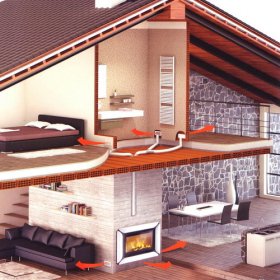
People invented a great many ways to get energy for heating their homes. The wood-burning stove and fireplace were replaced by gas boilers, solar panels, wind generators, heat pumps, etc. However, simply generating heat is not enough, it must be used with maximum efficiency. In many ways, the effective use of a precious resource depends on how correctly the heating system of a two-story house is selected.
Water, air and electricity
The owner of a modern private house has a large selection of heating options. The main ones are air, electric and water heating.
Option # 1 - heating with air currents
An air heating system must be provided even at the stage of drafting a heating project for a two-story house, since it is extremely difficult to install it in an already finished building. Air heating is a duct system into which hot air is pumped from a heat source.
Hot air rises and displaces the cold layers to the heat generator. In this case, air circulation can be gravitational, i.e. based on the occurrence of natural physical processes, or forced. In the latter case, the installation of a special fan is provided.
Air heating circuit It is considered beneficial from an economic and environmental point of view, since its implementation uses an accessible renewable resource - air. However, for the operation of the heat generator, gas or liquid fuel is required.
Note! When organizing air heating, it is necessary to provide for the possibility of air intake from the outside.
Option # 2 - heating the house with electricity
Among the methods of electric heating, devices such as:
- electric convectors;
- warm floor system;
- ceiling infrared heaters.
Often in the scheme of the heating system of a two-story house include "warm floor»As an additional heat source, along with air, electric or water heating.
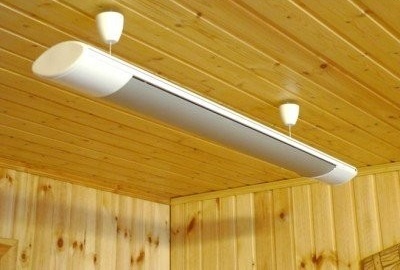
Infrared heaters are increasingly used for heating a two-story house. They are easy to install, efficient, safe and consume minimal amounts of electricity.
Electric heat usually used where other methods are difficult or impractical. It is enough to place infrared heaters and convectors in a suitable place and provide power supply. Installation of a “warm floor” system is also not particularly difficult: the heating cable is placed in a concrete screed or directly under the floor covering. The main disadvantages of this system are the dependence on the availability of electricity and the rather high cost of energy.
Option # 3 - traditional water heating
The most common heating option is a system of interconnected radiator pipes through which hot water circulates. To heat the coolant can be used boilers that run on solid or liquid fuel, gas boilers, as well as alternative options for generating thermal energy:
- solar panels;
- solar collectors;
- heat pumps;
- wind generators, etc.
Most often, a gas boiler is chosen for a private house, as the most economical option. Where there is no centralized gas supply, you can use liquefied gas in cylinders. Combined systems are frequent, in which, along with gas equipment, the possibility of switching to heating with solid or liquid fuel is taken into account.
If the owner of the house has opted for gas boiler, a heating scheme of a two-story house is drawn up, on which the placement of equipment should be indicated. Usually in a two-story house there is either a basement, or an attic, or both. It would be wise to install the boiler in one of these places.
Note! To transfer the coolant from the boiler installed in the basement, it will be necessary to supplement the system circulation pump.
One and two pipe heating circuits
An important point in the organization of water heating is the piping layout. Distinguish single pipe and double pipe schemes. When using a one-pipe heating system of a two-story house, radiators are connected in series with each other. As a result coolant circulates in a closed loop.
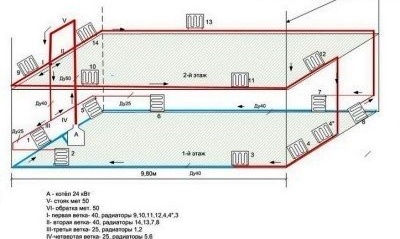
When using a one-pipe heating scheme for a two-story house, radiators are connected in series. To keep the house warm evenly, you need to install thermostatic devices
It should be noted that when using a single-circuit scheme, the radiators located at the beginning of the chain are heated more strongly, and the latter are weaker. To smooth this difference, use radiators of different sizes for different rooms.
Another way to make space heating even is to equip the system with special thermostatic equipment. In addition, it is recommended to install ball valves on each radiator, which will allow you to regulate the flow of coolant.
When installing a two-pipe heating system, a separate circuit with a coolant is brought to each radiator, which allows you to divert the coolant used for heating along a separate line. As a result, the premises are heated more evenly.
This is a more time-consuming and expensive method of organizing heating with a liquid coolant, but it allows, if necessary, to completely isolate a separate radiator for repair or replacement. In this case, the remaining parts of the system remain in working condition. With a single-tube scheme, this option is technically impossible.
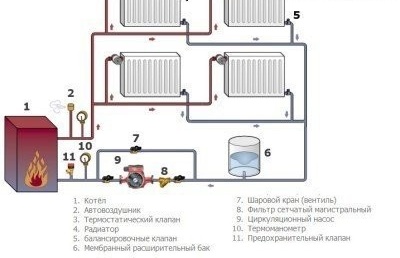
The two-pipe heating scheme of a two-story house provides for the creation of a separate circuit with a coolant for each radiator. The number of pipes required for installation is two times more than with a single-pipe system
Despite the obvious advantages of a two-pipe system, the serial connection of radiators has its supporters. They argue that with the right calculation, this approach is quite effective and can save a significant amount.
Visually, the features of these heating schemes are presented in the video material:
A few words about the calculations
An important step in choosing the right heating system is to calculate the possible heat loss. This indicator allows you to correctly calculate the power of heating equipment, the number of radiators, etc.
To determine how much thermal energy will leave the house, take into account the number and size of window openings, the number of doors, the presence of stairways and other factors.At the same time, air temperature of 23 degrees is usually accepted as a standard for residential premises, and 18-20 degrees for utility rooms. Heat can also go through the floor, floors, etc. You can do a more detailed calculation. here.
Quantitative heat losses depending on all these factors are in special calculation tables. The finished result should be increased by about 20-30% to take into account the heat that leaves through the ventilation.

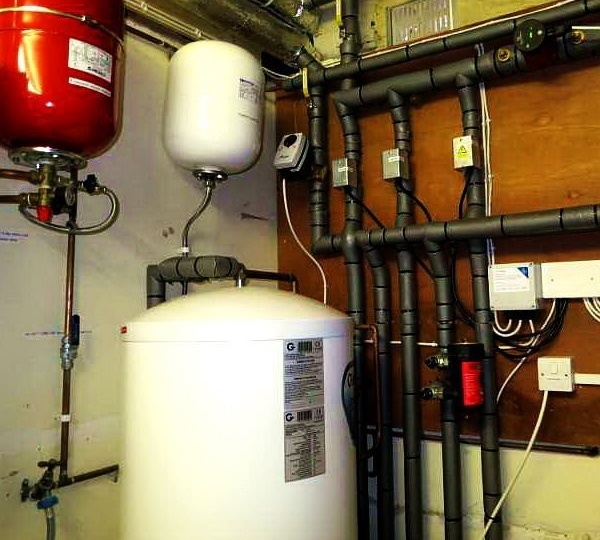

4 comments